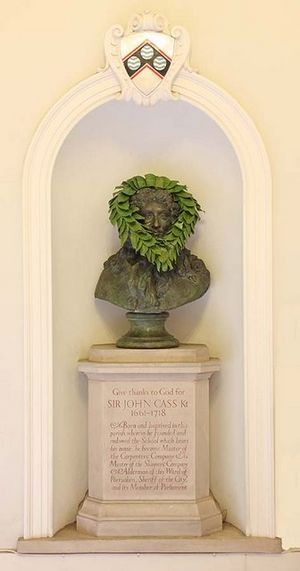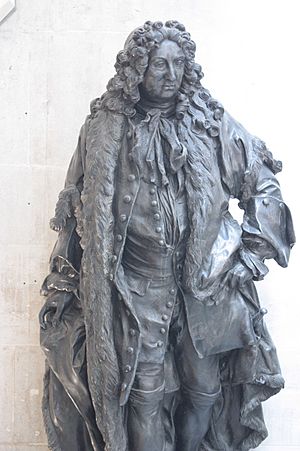John Cass facts for kids
Sir John Cass (born February 1661 – died 5 July 1718) was an English merchant, politician, and generous giver to charity. He was also a key person in the Royal African Company, which was involved in the trading of enslaved people.
Contents
Sir John Cass: His Life Story
Early Years
John Cass was born in February 1661 in Rosemary Lane, a part of the City of London. His father, Thomas Cass, was a carpenter for the Royal Ordnance, which made military supplies. John was baptised on 28 February 1660 at St Botolph's Aldgate church. In 1665, his family moved to Grove Street in South Hackney to escape the Great Plague.
On 7 January 1684, he married Elizabeth Franklin.
His Career and Public Roles
John Cass worked as a merchant, a builder, and a politician.
In 1705, Cass joined the Court of Assistants (like a board of directors) of the Royal African Company. This company had a special right from 1662 to trade along the West Africa coast. They traded in gold, silver, ivory, and, importantly, enslaved people. King Charles II and his brother James II (who later became king) set up this company with merchants from the City of London. The enslaved people were sold to work on tobacco and sugar farms in the Americas. Sir John Cass owned shares in this company until he died.
Cass was chosen as a MP for the City in 1710. He was part of the Tory political group. He was re-elected in 1713 but lost his seat in 1715. He also served as an alderman for the area of Portsoken from 1711. In June 1711, he was elected as one of the sheriffs of London. As sheriff, he was made a knight in June 1712, which meant he could use "Sir" before his name.
In 1711, he was asked to help with a plan to build 50 new churches. This was to help the growing population of London.
Cass was also the leader (Master) of the Worshipful Company of Carpenters from 1711 to 1712. Later, in 1714, he joined the Skinners' Company and became their Master. From 1709 to 1715, he managed the money for the Bridewell and Bethlehem Hospitals.
His Passing
Sir John Cass died on 5 July 1718, at 57 years old, from a brain haemorrhage. He was buried in the churchyard of St Mary Matfelon in Whitechapel, which is now Altab Ali Park. His wife, Elizabeth, died in 1732. They did not have any children.
Sir John Cass: His Lasting Impact
Starting a School
In 1709, Sir John Cass started a school for 50 boys and 40 girls. It was located in buildings near St Botolph's Aldgate church. He had written a will, but when he became ill in 1718, he wanted to write a new one. He had bought more property and wanted to include it. However, he only managed to finish two pages before he died.
Because the will was not fully finished, his family members argued over his money, which was worth £2,000. Lady Cass continued to support the schools until she died in 1732. The school continued for a few more years but closed in 1738. In the 1740s, the people who were supposed to manage Cass's money asked Parliament for help. Finally, 30 years after Cass's death, his will was accepted. This led to the creation of the Sir John Cass's Foundation in 1748.
The Sir John Cass's Foundation
The charity Sir John Cass started continued to fund the Sir John Cass Foundation School. It also helped set up the Sir John Cass Technical Institute in 1899. This institute moved to a new building in London in 1902 and became Sir John Cass College in 1950.
Later, parts of this college joined with other schools to form bigger universities. For example, in 1970, Sir John Cass College merged to become the City of London Polytechnic. This later became London Guildhall University and then London Metropolitan University in 2002.
Today, the foundation still supports several schools and parts of universities:
- A primary school in the City, near St Botolph's, called The Aldgate School (formerly Sir John Cass's Foundation Primary School).
- A secondary school in the London Borough of Tower Hamlets called Stepney All Saints School (formerly Sir John Cass Redcoat School).
- The Sir John Cass Faculty of Art, Architecture and Design at London Metropolitan University.
- The Bayes Business School (formerly Cass Business School) at City, University of London.
The foundation has also given money to the Sir John Cass School of Education at the University of East London and for a student hall of residence called Sir John Cass Hall in Hackney.
Looking Back at His Legacy

In May 2020, a Black man named George Floyd was murdered by a police officer in the United States. This led to many protests around the world. People started to think more about racial injustice and historical links to the slave trade. For example, in Bristol, a statue of Edward Colston, who was a slave trader, was pulled down.
Because of this, the Sir John Cass Foundation and other groups linked to him reviewed their names. Many decided to change them. London Metropolitan University removed Cass's name from its Art, Architecture and Design School. The foundation itself decided to change its name to The Portal Trust in Spring 2021. The business school at City, University of London also removed Cass's name, choosing to be called Bayes Business School from September 2021. The Sir John Cass Redcoat School changed its name to Stepney All Saints School.
Memorials to Sir John Cass
- A statue of John Cass was made in 1751 by Louis-François Roubiliac. It shows Cass wearing a long wig and a sheriff's gown. The original statue is now in the Guildhall. Copies are in other places, including outside the Sir John Cass School. On 21 January 2021, the City of London Corporation said they would remove the statue because of Cass's link to the Royal African Company. However, this decision was later changed. On 7 October 2021, it was decided to keep the statue but add information explaining John Cass's history and contributions.
- Cassland Road in Hackney is named after land the Cass family owned there. Until December 2020, the gardens on this road were called Cassland Road Gardens.
- Some old almshouses (homes for poor people) were first built in 1669. They were later supported by land Cass owned. In 1849, the Sir John Cass's Foundation rebuilt them.
- A statue of Cass was on the front of the Sir John Cass Foundation building in Jewry Street. It was removed in July 2020.
- At the University of East London, the education department was known as the Cass School of Learning. A statue of Sir John Cass in the building was removed on 11 June 2020 during the George Floyd protests. The university said they would review all historical funding sources and create a new naming policy.
- A memorial bust (a statue of just the head and shoulders) in St Botolph's Aldgate church was removed on 20 June 2020.



